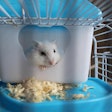I was very pleased to be invited to speak at the American College of Veterinary Internal Medicine Forum, held in Anaheim, California, USA, in June. My topics were carbohydrate-related claims for both horse feeds and petfoods.
My attendance at the meeting also afforded me the opportunity to learn much from the other speakers. Particularly interesting were several presentations on feline idiopathic cystitis (FIC) and how the understanding of the role of diet in its pathophysiology and treatment has changed.
Especially intriguing to me is how terminology evolves over the decades. In my early days working for a veterinarian, this condition was simply called cystitis, a very general term referring to inflammation of the urinary bladder. In fact, that term is the original basis for the abbreviation “c” in Hill’s Prescription Diet Feline c/d products.
While I was in veterinary school, the disorder was renamed feline urological syndrome (FUS), intended to refer (albeit vaguely) to a particular set of urinary tract signs. Later, the preferred nomenclature became feline lower urinary tract disease (FLUTD). Today, though, the vocabulary appears to have come full circle, with the predominant terminology again including the word cystitis.
FIC is typically characterized by frequent urination, straining and blood in the urine. It is diagnosed by ruling out other potential causes of similar signs (e.g., infection, bladder stones). While signs often resolve within a week, recurrence is common. In the most serious cases, the urethra becomes obstructed and the cat is totally unable to urinate, which if left untreated, leads to kidney failure and death. Because of these potentially serious consequences, it is a disease of extremely high concern to cat owners, even though it affects only a small percentage of the total cat population.
The term idiopathic means the cause is unknown. However, many potential causative factors have been implicated over the years, most often related to a dietary component (see sidebar). Some purported causes have subsequently been discounted—for example, high ash content.
Dry food is still often considered a factor, but since by one estimate up to 99% of cats receive dry food or a mixture of dry and canned food, it is hard to pin the blame on that aspect alone. Current US Food and Drug Administration (FDA) policy for allowing “helps maintain urinary tract health” claims assumes neutral to alkaline urine pH and, to a lesser degree, high magnesium content, to be major predisposing factors.
The most recent theory is that FIC is caused by stress. In fact, the hypothesis is that it is not a urinary tract disease at all, but rather a neuroendocrine disorder that is manifested by urinary signs. Thus, while there are many cat foods on the market with overt or implied claims relating to urinary tract health, in fact the food per se may have little relevance.
Treating FIC depends on the severity of the signs. If the cat is obstructed, emergency medical and/or surgical procedures are indicated. Otherwise, most times the signs dissipate in five to seven days regardless (or in spite) of medical or dietary treatment. Prevention of recurrence appears to be the key to long-term health, but an effective strategy remains elusive.
If stress is the cause, then relief of that stress may be the answer. The Indoor Cat Initiative at Ohio State University advocates multimodal environmental modification (MEMO), which involves making changes to the cat’s environment to mitigate activation of the stress response system. This may include changes to the housing and litter box conditions, use of toys, increased human interaction and even music!
Food is a part of MEMO. Changing from dry to canned food is often advised. The resulting increase in water intake may be helpful, but also both the mouth feel of canned food and the increased owner interaction achieved by the ritual of meal feeding are thought to positively affect the cat’s neurobiology. Feeding treats may also benefit by increasing the human-cat interaction.
While food is important to treatment/prevention of FIC, what appears unmentioned in the presentations I attended is any indication that specific dietary aspects such as effect on urine pH or magnesium content are important considerations, at least not to the degree once thought. In fact, it has been found that most cats with FIC already produce urine in the acidic range (<6.5 pH). This may be because the bulk of cat food products today are formulated to produce acidic urine, whether or not the company has pursued substantiation of a claim to that effect with FDA.
Regardless, if further investigation finds merit with the stress theory, the presumed role of diet and risk of FIC may be lessened to where claims for cat foods regarding urine pH or other dietary factors may be deemed to be unsubstantiated.


















